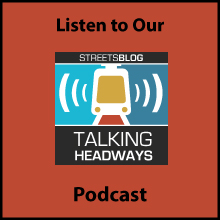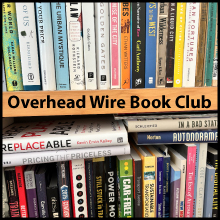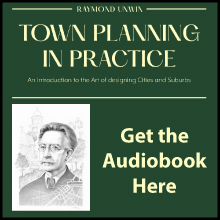Talking Headways Transcripts: Episode 271
March 1, 2020
We’re going to start posting transcripts for the Talking Headways podcast episodes. We did a test a week or so ago and it turned out pretty good. So here’s episode 271 with David Levinson. I’ve also posted the audio at the top as well.
JW: (0s):
You’re listening to the Talking Headways podcast network. This is Talking Headways, a weekly podcast about sustainable transportation and urban design. I’m Jeff Wood. This week we’re joined by Professor David Levinson of the University of Sydney for part two of our TRB discussion this week. We chat about the creation and politics of research journals and his new book The 30-Minute City. Stay with us.
JW:
So I wanted to ask a different type of question. We’re at TRB, this is based on research, a lot of it, there’s poster sessions probably going on right now and all day every day for the next couple days. You started two journals. What made you want to start those two and get that going? And I really appreciate them by the way, General Transport and Land Use specifically.
DL: (2m 17s):
Yeah, so General Transport and Land Use is on sabbatical in London. I had talked with Kevin Krycek about a journal in this area. So Kevin was a colleague of mine at Minnesota for a few years, through 2007 or so before he moved to Colorado. We were teaching the transport and land use course at the Humphrey Institute at the time, and there wasn’t a journal in that field so we had thought about it. We had thought deeply about open access or philosophy at the time initially when we had thought about the journal. We talked to Elseviere, they said, “You know, how many papers you think you’d have a year? We said, I don’t know, 25? They said that’s not big enough, we’re not interested,” like okay, whatever. Then in 2007 I start reading more about the open access movement. A colleague of mine who was sharing my office, Stefan Hess, started an open access journal, Journal of Choice Modeling and you know, it’s like if this postdoc can start a journal, I could start a journal. And so, you know I thought about it a little bit more as like, well we’ve been thinking about the general transport land use, open access is a good model because it was hard to access journal articles at the time. I mean, there was an internet of course, but unless your library subscribes to the journal you might not be able to get a particular article. Indexing wasn’t as good as it is today, and there was no Sci-Hub. I don’t know if you’re familiar with Sci-Hub.
JW:
I’ve heard of it.
DL:
So Sci-Hub is a Russian site which provides access, which is probably not legal in many countries to get, to almost every journal article that’s ever been written. So they’ve downloaded articles from university libraries and hosted them on web servers in Russia. So if you want an article and you go to the Sci-Hub website, you can find the actual address in Wikipedia. It moves from time to time. You can get access to any article if you know its title, author, or digital object identifier (DOI).
JW: (4m 0s):
So is it like Pirate Bay…
DL: (4m 4s):
It’s like Pirate Bay for journal articles, and they’re being sued, and there’s accusations they’re being backed by the Russian Secret Service and using spy agencies and stuff like, you know, whatever. It’s a way that you can get articles now that you couldn’t get them before, and I’m not saying it’s legal, I’m just saying it exists. But at the time it was a lot harder, and journal subscription rates were going up and everyone was knowing that, and Elsevier was very profitable, and it’s like okay, we can start up our own journal. University of Minnesota was kind enough to provide us support, and then we started Wstlur, the World Society for Transport and Land Use Research which hosts their conference every three years, and that helped sponsor the journal as well, and we’ve got sponsorship from some other universities overtime. UC Davis has given some money to support the journal. And that’s done reasonably well, the first few years we’re publishing 10 articles a year and now it’s 50 articles a year. I stepped down last year as the editor-in-chief of that, Yingling Fan is now the editor.
And we start up Transport Findings, and Transport Findings, one of the things that I’ve noted as an author is that the review process is especially painful. You submit a peer-reviewed article, and reviewers want you to add things that you don’t think are particularly relevant. They want you to cite their own papers, though they don’t say it in quite those words usually, sometimes they do, but they want extended literature reviews that have nothing to do with what you actually did as a researcher. And my view is that the core of the paper is actually much smaller than what we see. I mean they ask us to submit a 4000 or 7000 or 9000 word paper, but if you look at what was actually done, there’s a thousand words of research in there. So Transport Findings says, you write a thousand word article. And there’s three parts: a research question and hypothesis, methodology, and your findings. I don’t care about the policy implications, people are probably smart enough to figure those out. I don’t care about the literature review. You just need to cite something if you used a particular method that somebody else developed, you cite that, that’s fine. But we don’t need the full history and the regurgitation of all knowledge that came before, because that’s just people collecting citations essentially. And focus on what’s important in the research. And we think about what is the actual research that you did, if you focus on that, A) it takes you less time to put out a paper, which is good from your perspective because then that time can be used to create more research rather than writing a longer lit review of things that people already know. And if we can turn the page paper around faster because the review burden is less, reviewers don’t have to spend as much time, and they’re not asking for things that don’t belong, then the paper can get published faster. So in the first year we published about 36 articles in Transport Findings, about a thousand words each. I won’t say that they’re all under a thousand words, but that’s the target. And three tables, three figures, open access, go to transportfindings.org you can download all of them.
And I think science especially in the transport field, but probably throughout the social sciences, has become especially cumbersome in needless ways. And you know, we need to think about what does it mean to do science? You look at the original Royal Society back from the 1600s. They were basically letters of, “I thought this was interesting, I did this, and this is what I found” and you know, they’d say it in I guess late Middle English, early modern English, but it’s what they actually did. There was no literature to review for them. And you know, they might say, oh so-and-so discovered this, so we looked at this other thing. But the peer review was the editor thought it was interesting and would distribute it to other members of the society. And I think we need to at least look back at our roots and understand what is it we’re trying to do in science. And so much of this becomes a game for people, and it becomes a game because we have to do promotion and tenure which is a process in the academy and which means in the US system especially it’s a problem.
And other countries are emulating the US System, where if you’re an assistant professor in your sixth year typically you’re going up for promotion and tenure, going up for promotion to associate professor and tenure which is essentially a job for life unless you really screw up. So it’s existential. And the way that’s decided is you get 10 external letters from people at other universities who say, “Yeah, he’s a good guy or she’s a good person,” and you have your colleagues in your department saying, “Yes, he’s collegial,” but you also have people in the faculty or your college outside of your own school, who are looking at you who are not part of your field who have to decide whether you’ve done good work. How do they decide if you’ve done good work? Well, they look at your citations. But you’re young, you haven’t had a lot of time to look at your citations and citations are an indicator that other people think your work is good. And they look at where you’ve published. So have you published in highly ranked journals? And that’s terrible, cause that’s a self-fulfilling type of system. And they look at how many publications you have and you know, it’s how much output you produced, but we don’t know if any of it’s any good. And so people slice and dice their research. They publish essentially the same thing in different places and five times. And we can’t solve all of those problems with one journal, but there are these series of problems in academia that lead to, you know, bean counting is important not just for promotion and tenure, it’s important for international rankings, which is important to deciding from other parts of the world, international students, which universities are going to go to is based on the ranking, and the ranking is based on citations, and the ranking is based on publications in particular journals. And so this whole thing has become a giant bean counting game, and then senior administrators at universities put pressure on junior faculty members to produce certain kinds of publications that satisfy this. And so you have to get published in a particular journal, and to get published in particular journals you have to comply with what those journal reviewers want, and so you can’t anticipate that. But then they tell you to do ridiculous things in the review process, and you do the ridiculous things because doing the ridiculous things is less painful than having to start a review process over again at another journal. There’s a sunk cost that you’ve committed, and it’s like, “Is it better to go through a second round here or start a first round there?” And if they’ve given you a revise and resubmit type of letter you’ve already gotten to the first stage of this, you know, you’re closer than not having had that letter in a second journal which might not be as highly ranked.
And that’s I think one of the other problems that we have, and it’s like publication is good, we want to get science, but but having to go through papers that have three rounds and four rounds of review to satisfy a reviewer who wants your research to have been a different research paper… I don’t think that’s right. I don’t think that’s good for science. I think it’s healthy for society and we need different models. And Transport Findings is one where we just say, you publish what you found, we will have a review process to make sure that that looks like what you actually found and you actually did the work, but we’re not going to ask you to redo your paper to have done something different or wish the paper is what we wish you had written. Is the paper that you wrote a valuable addition to the body of knowledge? And it’s not like, “is it important?” Because I can’t assess importance. Is it true? I can try to assess, does it look true and does it look like it’s scientifically valid, you know, you counted things right, you added things, up properly, the method you use hasn’t been invalidated previously, you know, it seems like the right way to have done it. If I can produce science, which is what I’m supposed to do as a researcher rather than focusing on the games, I’m better for it.
Now the problem is, is this journal going to be treated the same as other journals? We hope it will be over time. It’s open access so it should increase readership and if it increases readership, there’s evidence that it increases citation. It’s relatively inexpensive, you know, you look at open access charges at some journals. So like some of the big open access journals like PLOS One are charging in the 1200 to 1500 dollar range, some of the Springer journals are charging in $3,000 range to get an open access journal. What does it actually cost to lay out a paper? It costs about $50 to $100 per thousand words. That’s what it costs. So you’re talking about a 1000 word paper costs a hundred bucks, maybe, to produce so we charge you a hundred bucks. Is it publication fee? Not $1000 not $1,500. I don’t know where these costs come from. A part of it is the papers are long, and they’re laying out stuff that doesn’t actually need to have been printed in the first place because it’s a regurgitation of the literature review or it’s the statement of a problem that’s largely obvious or has been well documented elsewhere and we don’t need to include everything we’ve ever learned up to this point in this particular paper. This is the unit of knowledge that I produce. This is my contribution, I don’t need that other stuff, this is what I did.
JW: (12m 22s):
And the reviewers aren’t getting paid either.
DL: (12m 24s):
The reviewers aren’t getting paid! Oh, this is yeah, reviewers getting paid. Okay, so I’m in a small war with an Elsevier journal right now because they asked me to review a paper and I declined, and then the editor asked me again in a way that basically implied that I wouldn’t get my papers reviewed if I didn’t do reviews for them. And it’s like well, okay. I’m not gonna send my papers there anymore. But it’s like why am I reviewing papers for free for Elsevier? They are one of the most profitable companies in the world. Springer Nature is also fairly profitable and some of these others. It’s like there are open access journals out there. There aren’t enough of them. I mean I can only found so many myself and publishing in my own journals, you know people will question that more than publishing in somebody else’s journals because of conflict of interest types of issues. But why should I send it to an Elsevier journal that’s profiting off of the paper, right? They’re selling a subscription to libraries around the world–University of California has recently withdrawn from the Elsevier system and some of the European countries are also withdrawing from paying for Elsevier journals, but they still sell to most of the libraries in the world. They still own a lot of the key journals in the transport sector especially, and they’re profiting off of my paper which was paid for by the public sector, and then they want me to review a paper for free and my name isn’t associated with that. I don’t even get social capital from that. This makes no sense. And we do it because we have a promotion and tenure system that historically rewarded, “Well, you know, did you do reviews?” One of the things that you list in your academic CV is that you reviewed for these journals, and it’s like, it’s a bean counting exercise. It shows that you’re participating in the greater academic enterprise, but I would rather be limiting my contribution to doing something that’s beneficial for society or in an open access way and if Elsevier wants me to do reviews, I’m happy to do that for a price.
Some journals in this world pay for reviewers, most of them don’t. It’s like, well if you were a society journal and you don’t have any revenue, I understand that, but if you’re charging subscription rates of millions of dollars for the bundle of your journal and you’re making a profit, if you have a profitability rate higher than Apple computer, you can pay the reviewers. You can pay your editors more money than you’re paying your editors. And everyone just sort of meekly bends over and takes it, rather than actually standing up and saying no, I’m not going to do this anymore. I’m not going to participate in this system. I mean, I have the luxury I earned tenure in the US System. I don’t have tenure in Australia cause they don’t have tenure there, but you know, it’s like they’re not going to fire me for this I’m sure. You know, we need to be able to say, “No, I can get tenure some other way, right? I can publish articles in open access journals, I don’t need to publish in journals that exploit people, exploit reviewers.” I mean, the reviewers are nominally volunteers, but you know, if we’re being threatened then it’s not fully voluntary at that point, if we’re being threatened with not being able to access a resource that we need for our career. And if you don’t publish in any of the Elsevier transport journals as a junior academic and you’re in the transport field, it’s going to be hard to get promotions. I mean they’re going to look at you, “You didn’t publish in any of these journals?” I mean like they own eight of the top 10 highly ranked journals. I mean I’ve published in them in the past. So that’s bad behavior on their part. They’re exploiting it as, you know, as capitalists that they should exploit it, you know from their own point of view, but as the other end of this exchange, we shouldn’t be allowing them to exploit it.
And I think we need more open access journals out there. We need more alternative publication outlets, and we need to rethink why we’re going through a process that takes several years to get a piece of research through a peer-reviewed journal. I mean the transport field is actually changing quickly now, I mean, it was one thing in the 1980s or the 1990s when the field was pretty sleepy, but we’ve got new technologies coming on board every year, every six months. If it takes you two years to write a paper about and get published in a paper about micromobility, there might not be micromobility anymore. It might be a history paper by that point, so it needs to come out a little bit faster. Transport Findings, we can turn it around faster, because they’re shorter and because the process is simpler. And we need more journals that I think that are like that and focused on observations, and then periodically we do reviews and then we sort of synthesize the literature and collectively what do we know about? You know, there’s room for theory papers and there’s room for more complicated papers as well. But I think sort of the simpler papers have gotten pushed by the wayside. You have to have a complex paper in order to get published in the system as it largely exists.
JW: (16m 48s):
This morning, I woke up, and this is tangentially related, but this morning I woke up and I noticed that my first tweet on the top of my bar was that Guardian Cities is no longer, they’re not going to publish any more work. Which I don’t know if you saw that but this morning it was like the first thing I saw, and I was really bummed out. And so, you know, there’s there’s all this research out there that academics are doing and then you know, they’re in papers and the people like me can’t necessarily access them. I’m not at a university, and I’m not going to pay $15 for a paper of you know, two thousand words or whatever.
DL: (17m 18s):
And it’s friction to go and find the author and then email the author, and they’ll usually be happy to send it to you, but we all know the email system is broken, and many emails don’t get read, and people are busy, stuff slips through. And so you get it a week later than when you needed it, if you get it at all. Yeah and Citylab of course just got…
JW: (17m 36s):
…acquired by Bloomberg…
DL: (17m 37s):
…and half the staff was laid off, so…
JW: (17m 39s):
Governing disappeared earlier this year… And so the access, you know, we’re talking about accessibility earlier for people and transport but access to interesting pieces about urban areas and cities and transportation is dwindling as well.
DL: (17m 51s):
Yeah. I mean, it’s perfect role for your newsletter to fill some of the void.
JW: (17m 56s):
We try, but if there’s nothing for me to share then that’s another issue too.
DL: (17m 59s):
Right. They were funded by Rockefeller. Yeah, and Rockefeller pulled out of the Resilient Cities thing a few years ago.
JW: (18m 6s):
Yeah, earlier this year. They have a five-year cycle. I think. That’s their funders, but being dependent on funders, that’s another thing.
DL: (18m 12s):
Right and so one of the things about Transport Findings is you know, it’s dependent on the authors, but we don’t have any sponsors aside from me for the startup cost, but once we get to a certain level of submissions per year, it’s self-sustaining and that’s the beauty of this. And it’s like, we’re not dependent on a sponsor. And as great as Center for Transportation Studies at University of Minnesota has been for JTLU, in the end they only contribute as much as they contribute, and they might change leadership at some point in the future and change their direction, and then that resource disappears. The journals should not be dependent on a patron. They should be dependent on the people who benefit from the journal publication process, which are the authors or the readers, and the authors probably have a lot more interest in getting a publication out than a reader does in reading it in a complicated world. So you know, we sort of think about, what is the model, I mean libraries used to act on behalf of readers, and it’d be great if libraries could provide more money to support open access publication charges on the part of authors, and then it would be available free to the world. I mean, the marginal cost of distribution is close to zero. It’s not perfectly zero, but it’s close to zero. But there is cost of the production of the paper, which suggests you charge the authors a little bit, which means you charge the researchers. But you’re providing something for society, and it’s a relatively small cost compared to the cost of doing the research in the first place, especially for large scale funded research projects. I mean some of the papers are master’s thesis results that are perfectly good findings and need to get distributed, but a masters student isn’t going to spend two years to go through a revise and resubmission process three times on a journal article. It’s a hard claim to ask of anybody, but especially for someone who’s not going to go on to an academic career. And I think that’s you know, another one of the failures of the system, only people with a very long time horizon professional academics can justify spending the time to publish in the peer-reviewed literature, and that makes it more elite-oriented, exclusive, and less valuable to the world.
JW: (20m 8s):
Yeah, speaking of easily distributed: you just released a new book in December, right? And the PDF is like eight dollars or something?
DL: Yeah, $8.88.
JW: Easy to access. So The 30-Minute City…
DL: (20m 19s):
The 30-Minute City: Designing for Access, and the idea of the 30-minute city is essentially an accessibility concept. It’s sort of the centerpiece of the Greater Sydney Commissions’ Metropolis of Three Cities plan, was this idea of a 30-minute city. They have different definitions of the 30-minute city different places in the document. But the idea is that people can reach the things that they need within 30 minutes or that people can reach their local center in 30 minutes by public transport or walking or biking. And they called it the Metropolis of Three Cities. So they divided the Sydney region into three cities: the eastern, central and western parts, and the eastern part is the Sydney that everybody knows about, centered on the Circular Quay in the harbor where the Opera House is. The central city is centered on Parramatta and the Western city is centered on the new district which they’re calling Aerotropolis. The Western Sydney airport is being constructed now, and there is suburban development in some towns that are out there, and that is where most of the growth is occurring because that’s where most of the available land remains. And so they’re building public transport to serve the central and the western regions as well, and so there’s not just going to be a hub in the Sydney CBD but there’s also going to be a transit hub in Parramatta and a transit hub in Western Sydney, with radial roots coming out from their relative centers. Which is an interesting model. It’s a 40-year plan for 2056 released in 2018. Which if you do the math is a 38 year time period, there was a 40 year plan when they started it probably.
The idea underlying it of accessibility is something that, you know, certainly large public Investments are important to help achieve, but one of the things I wanted to point out in the book is that there are a lot of ways of improving accessibility that are relatively low hanging fruit. The simplest of which is you have train stations with entrances on one end of the platform and there’s another end of the platform that if you got off the train there you’re walking two minutes down the platform before you exit the train station and you might live on that side of the train station. So then you have to walk back around the train station again, four minutes now before you get to sort of where you started from. And it’s not that expensive to put in a second entrance on a lot of train stations, but the people who are designing train stations have a different objective than people who are concerned about maximizing regional accessibility, and the people who are maximizing regional accessibility don’t think at such a microscale. They think of a train station as the dot rather than a space, and we need to connect those two scales. And there’s lots of places you look in the world around you, and there’s these inefficient designs. Traffic signals is another thing where Sydney especially is designed to minimize automobile travel time, but one of the ways it does that is by maximizing pedestrian time. Pedestrians have a walk signal of six seconds every two minutes. Here in Washington DC, you look at the intersections and there’s a countdown timer and the pedestrians have almost as much time as the cars do. It turns to “don’t walk” a couple seconds before cars because pedestrians take a little bit longer to cross the intersection. It’s like, okay, from a traffic engineering point of view, that’s pretty standard, but they also get a leading pedestrian intervals. They get start crossing before cars do so that they’re in the crosswalk before cars start to make the turn so they’re more visible to the automobile driver when they’re crossing. And things like that which could improve the accessibility by walking in a place like Sydney by up to potentially, I mean in the no signal environment you could increase your accessibility by 50%. The amount of time spent waiting for traffic signals is 20 to 30% of your travel time in an urban area, and we can do better than that if we actually thought about it and cared about and prioritize the things that we say we’re prioritizing in our plans. And we can prioritize them at an engineering level and at a project design level.
So that’s the idea behind the book, you know things that, they don’t seem like they’re hard to do but politically you get agencies that say, “Well, we don’t want to put in a second entrance because it makes it harder to police or to control people entering the transit station.” Well, maybe it’s harder to police people entering the transit station, I don’t know, you could put a gate there and a camera and you know, if there’s a real problem then you put police officers out there, but you’re sort of the speculated fury. I mean it used to be more expensive because you have to collect actual tickets and you need staffing at your entrances, but that’s not true anymore. You know, everything’s with smart cards and smartphones you just tap on and it’s like I don’t really understand the excuses that they give. I mean, I know what they are, but I don’t believe that they’re valid and some of these, it’s like the question of simply cutting a hole in a fence. At least to give some access. I mean, it’s something that a guy could do in an hour with the right pieces of equipment, you know, and nobody has the authority to do it, you know, some things are more expensive. Building an overpass or something like that, but it’s still not expensive in the scheme of things compared to the amount of accessibility that you get. But building the $15,000,000,000 metro system? That’s politically easy and and I don’t understand why that’s politically easy, but putting a staircase in existing train station is politically difficult, but that’s the world we live in.
JW: (25m 29s):
So where can folks find you online?
DL: (25m 31s):
Transportist.org is my blog and homepage, and then I Twitter at transportist no vowels: @trsnprtst. Also on LinkedIn under my name, but I tend to be most active on my blog and on Twitter right now. I’m debating whether, I mean, I know social media is very bad and the question is whether I should continue to participate in social media.
JW: (25m 55s):
I wish you would keep participating because I appreciate your posts.
DL: (25m 58s):
Thanks. You know, I just fear that it’s going to lead to the end of the world…
JW:
But you’re not going to lead to the end of the world.
DL:
I’m personally not going to, but I’m participating in a system and maybe if I didn’t participate in the system I could help change the system.
JW: (26m 10s):
Well, David, thanks for joining us. We really appreciate it.
DL: (26m 12s):
Thank you for having me.
JW: Thanks for joining us. The Talking Headways podcast is a project of the Overhead Wire, on the web at overheadwire.com. Sign up for our free month trial, the Overhead Wire Daily, our twelve-year-old daily cities news list by texting the word “cities” to 42828. That’s “cities” to 42828, and please please please support the pod by going to patreon.com/theoverheadwire. Many thanks to our current patrons for their ongoing support. And as always you can subscribe to this podcast on iTunes or stitchr or soundcloud or overcast or Spotify, or wherever you get your podcast. And you can always find its original home at USA.streetsblog.org. See you next time at Talking Headways.







